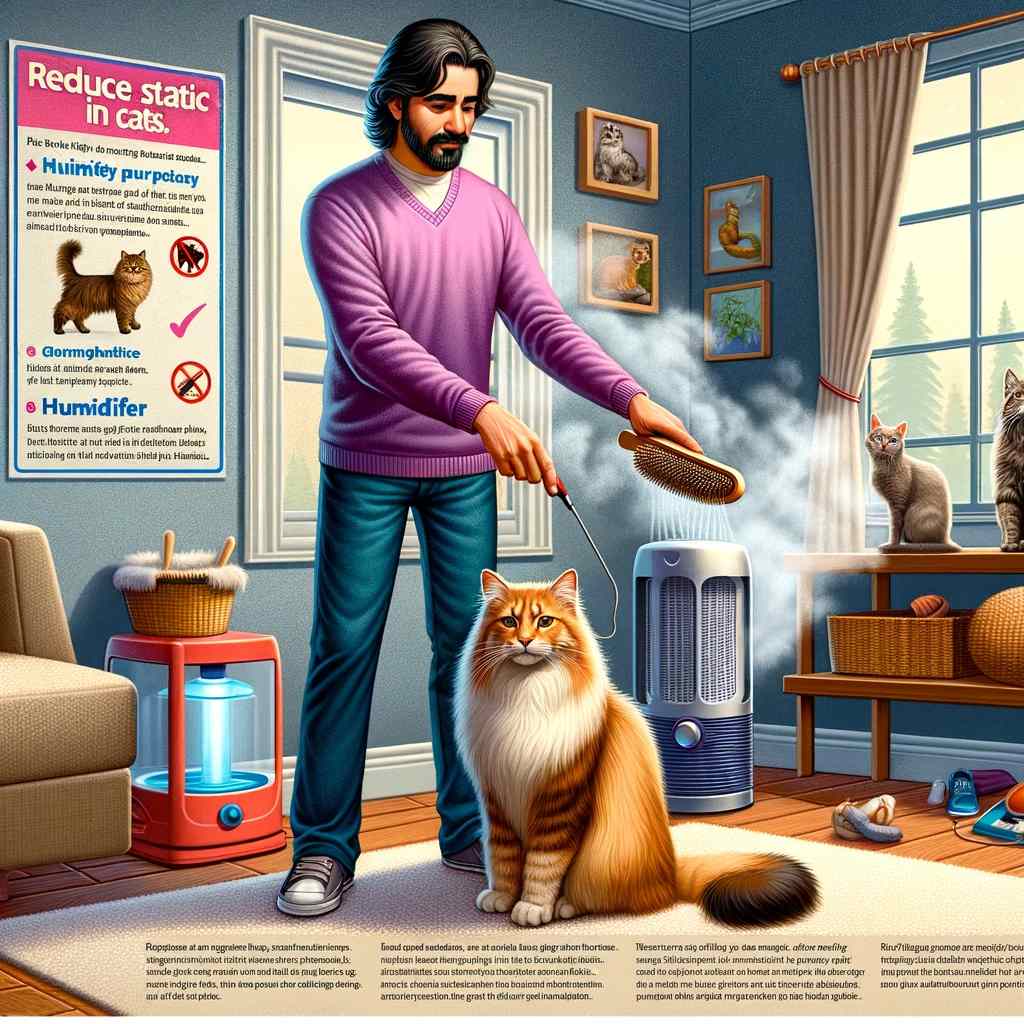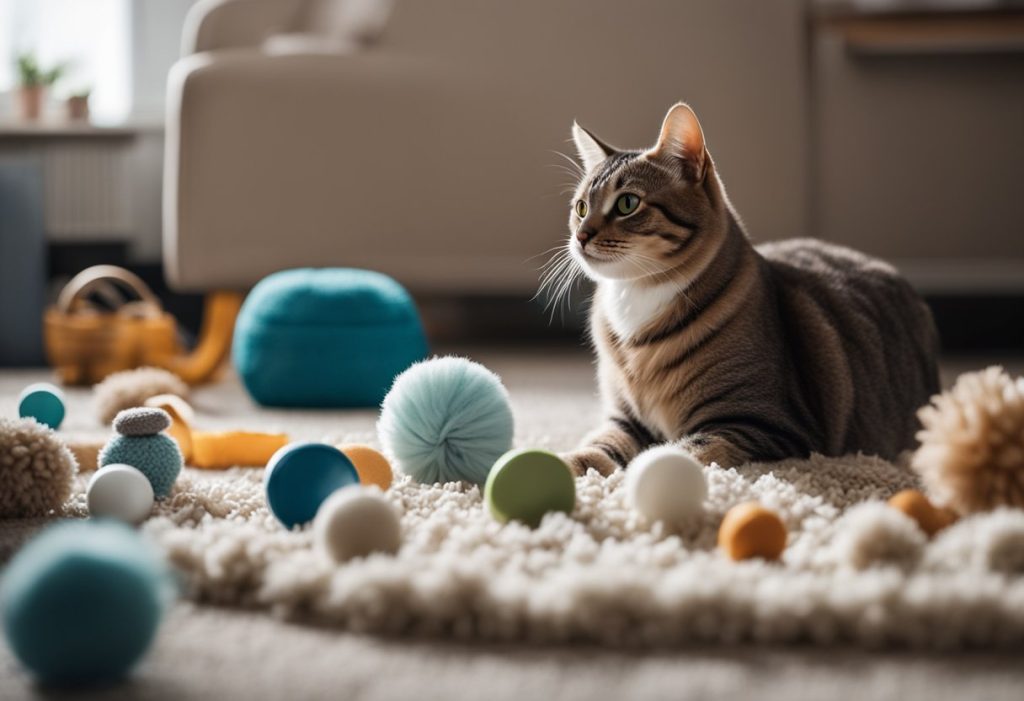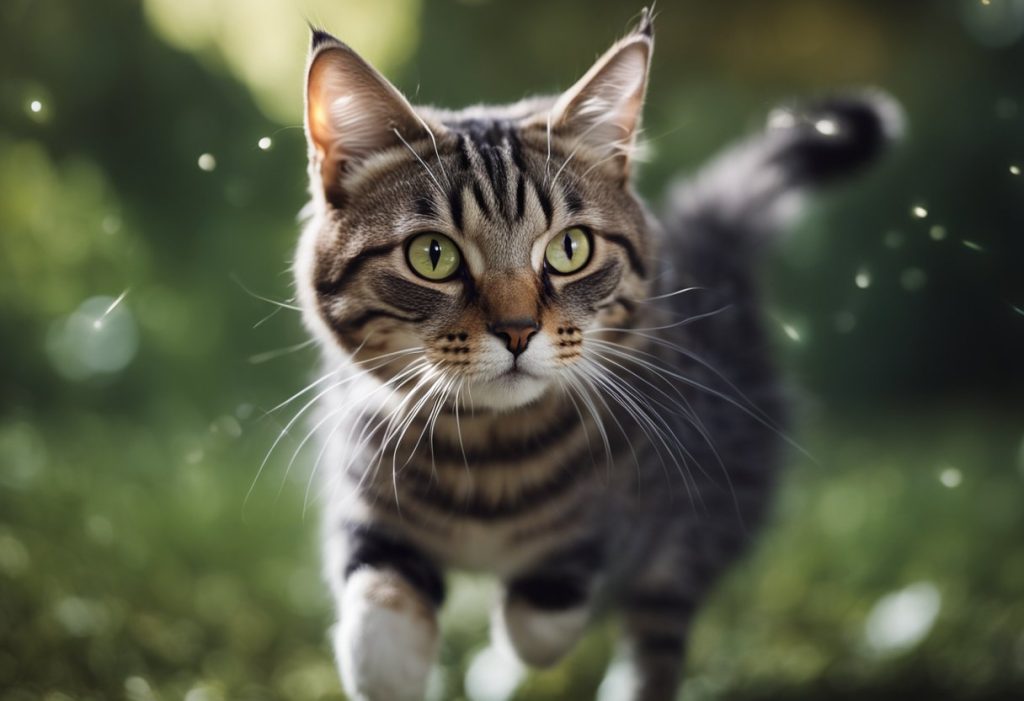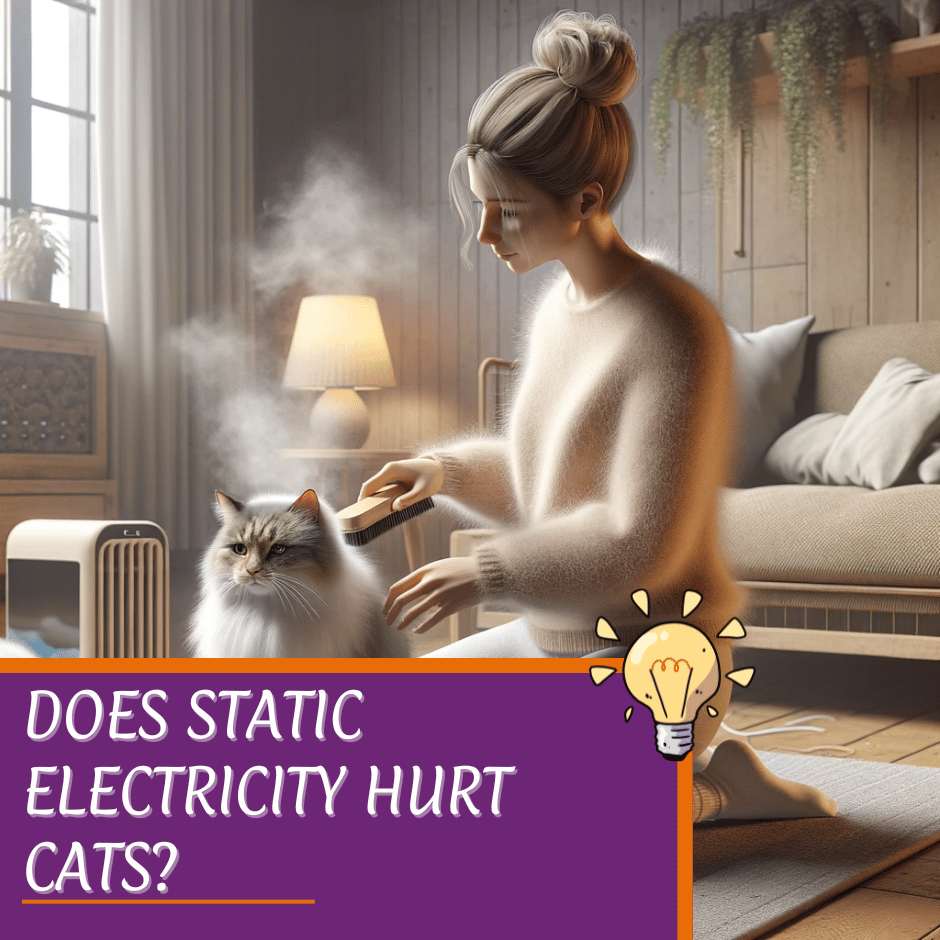Feeling a little zap when you reach out to pet your cat may make you both jump, but is it actually something to worry about?
Static electricity is pretty much a clingy guest in homes during the winter months when the indoor air is dry.
Your fluffy friend’s fur is a perfect insulator, and the friction created from them cozying up on blankets or you stroking their back is like rolling out the red carpet for static charge buildup.
Sure, it might give your cat an amusing case of “fur-stood-up” style, but beyond the visual comedy, it can lead to discomfort.
You might wonder if this static can hurt your cat beyond just giving them a surprise.
Luckily, while static electricity can cause some stress and anxiety in sensitive felines, it’s not harmful to their health.
Nevertheless, an attentive pet parent like you might notice your cat becoming a bit more hesitant for cuddles during peak static seasons.
Understanding how to manage and reduce static electricity in your cat’s environment can create a more comfortable space for them and keep the petting sessions as enjoyable as they should be.
Key Takeaways
- Static electricity in cats is not harmful but can cause discomfort and stress.
- A cat’s fur can accumulate static charge, especially in dry conditions.
- Reducing static and managing the cat’s environment can improve their comfort.
Understanding Static Electricity in Cats

Have you ever noticed your cat’s fur standing on end, or a small spark when you go in for a cuddle?
These phenomena are all due to static electricity, which is pretty common in cats, especially during the drier months.
But what exactly is happening here, and should you be worried about it affecting your furry friend?
What Causes Static Electricity in Cats?
Static electricity is all about the unexpected science of snuggles.
When your cat rubs against various surfaces—or you give them a good petting—the friction generates a charge.
Their fur, much like our own hair, stands on end due to this charge causing individual hairs to repel each other.
- Dry Air: Low humidity levels can make static electricity more noticeable. Indoor environments, especially in winter with the heat on, can have very dry air and low humidity.
- Friction: The contact and separation between your cat’s fur and other materials, like your clothes or bedding, increases static charge.
Does Static Electricity Hurt Cats?
While it might surprise them, static electricity is generally more startling than harmful to cats.
Those little zaps can create static hair, which can look funny but may cause some discomfort or stress.
Imagine how you’d feel with your hair constantly standing up!
- Discomfort: The sensation of static electricity might be weird or unpleasant for your cat.
- Stress: Repeated static shocks can stress out your pet, making them somewhat anxious or causing them to avoid certain areas or activities.
To keep your kitty comfortable, maintaining a good humidity level in your home and using anti-static remedies can help.
Remember, your cat’s well-being is a top priority, and a stress-free cat means a happy cat—and a happy you!
Identifying Static Electricity in Cats

You’ve probably felt that unexpected zap when touching a doorknob, but what about your feline friends?
Let’s explore the telltale signs that indicate your cat is experiencing static electricity.
Physical Signs of Static Electricity
If you’ve noticed your cat’s fur standing on end or sparks when you pet them, it’s a clear physical sign of static electricity.
Their fur can become a natural insulator and when charged through friction, such as rubbing against furniture or walking on carpets, it leads to a build-up of electrical charges.
You might observe:
- Static hair: Fur seeming puffier or strands sticking out.
- Sparks or visible discharge: Though rare, tiny sparks can sometimes be seen.
Behavioral Responses to Static Electricity
Your cat’s behavior can also give away their static predicament. Static electricity might cause discomfort or even mild stress, noticeable through:
- Sudden jumps or twitches: When static builds, the unexpected discharge can surprise your cat during petting.
- Increased grooming: Cats might lick themselves more in an attempt to rid the uncomfortable sensation of charged fur.
Remember, while it might be a startling encounter for them, static electricity usually doesn’t harm cats, but it’s your job to ensure their environment is comfortable and stress-free!
Keep an eye on these signs, and you’ll be well-prepared to help your kitty stay zap-free.
Managing Static Electricity in Cats

Have you ever reached out to pet your cat and been greeted with a little zap? It’s not just surprising for you – it can be pretty startling for your kitty too!
Let’s get into how you can make your home a static-free zone for your feline friend.
Home Environment Adjustments
First things first: let’s talk humidity. Dry air is often a culprit when it comes to static build-up.
Grab a hygrometer to keep tabs on your home’s humidity levels.
You’re aiming for a comfortable 30-50% range.
This not only helps with static but can also improve air quality!

Top Picks: ThermoPro TP49 Digital Hygrometer Indoor

Humidifiers and Moisture Levels
Is your air drier than a desert?
It might be time to introduce a humidifier into your home.
Humidifiers add essential moisture to the air, which can drastically reduce static electricity.
Plus, they’re great for your skin, too!
Just remember: too much moisture can encourage mold growth, so keep a balanced approach.

Top Picks: Afloia Air Purifiers for Home

Choosing Appropriate Fabrics and Materials
Now, let’s talk textiles. Your couch and clothes might be stylish, but if they’re made of synthetic materials, they could be contributing to static shock.
Opt for natural fibers like cotton or wool, which are less likely to generate static.
When it comes to bedding or blankets your cat loves to kneel on, the same rule applies.
Top Picks: Kritter Planet Anti-Static Waterproof Blanket

Practical Solutions for Cat Owners
Ready for some hands-on solutions? Here’s a quick list to zap that static away:
- Brushing: Regular grooming with a metal brush or an ionic brush can keep static at bay while keeping your cat’s fur smooth and shiny.
- Anti-Static Sprays: A quick spritz of grooming spray right before petting can do wonders. Just be sure it’s cat-friendly!
- Damp Towel: Gently wipe your cat’s coat with a moist towel to minimize static. It’s a simple yet effective method.
- Avoid dryer sheets. They might be tempting to use for a quick fix, but many can be toxic to cats.
Remember to integrate these tips into your regular routine to keep your feline’s fur fabulous and free of those pesky zaps!
Long-Term Strategies for Reducing Static Electricity

Static electricity can be a shocking experience for you and your kitty, but don’t worry!
With these long-term strategies focused on nourishing cat fur and tweaking the living environment, you’ll zap away those pesky sparks in no time.
Diet and Nutrition for Healthy Cat Fur
Did you know that what you feed your feline friend can impact how much they light up your life—literally?
A diet rich in Omega-3 and Omega-6 fatty acids can do wonders for your cat’s coat, making it healthier and less likely to generate static electricity.
Remember those Maine Coon beauties you admire? They especially could use a diet that helps keep their fur magnificent and static-free.
- Omega-rich Foods:
- Salmon
- Flaxseed oil
- Fish oil supplements
Environmental Modifications
Creating a static-resistant environment is like setting the stage for a fur-tastic play where static is the uninvited guest that can’t stick around.
- Humidity: Getting a humidifier can vastly improve the moisture levels in your home, defeating static at its own game.
- Fabrics: Natural fibers are your best bet for bedding and furniture. Unlike synthetic fabrics, they don’t throw a static party.
- Flooring: If you’ve got carpets that love to cling to your socks (and your cat), consider using rugs made of natural fibers or adding anti-static treatments.
- Grooming: Moisturizing shampoo, anyone? It’s like a spa day for your cat’s fur, and it helps cut down on static.
Keep these tips in your back pocket, and you’ll be well on your way to a less shocking cuddle session with your favorite feline.
Understanding Electric Shock Injuries in Cats

Ever wondered the difference between a little static zap and a full-blown electric shock for your furry friend?
Let’s dive in to keep your cat safe and sound.
Differences Between Static Electricity and Electric Shocks
Have you ever petted your cat and felt a tiny spark? That’s static electricity and generally, it’s not a big deal.
Static is simply the discharge of electrons after friction, say, between your hand and your cat’s fur.
Now, electric shocks are a different story. Electric shocks can happen when your kitty nibbles on a wire and can cause serious health issues. (1)
While static just messes up your cat’s hairdo, electric shocks can affect their health.
Signs and Symptoms of Electric Shock
Watch out for these alarming signs if you think your cat has experienced an electric shock:
- Seizures
- A state of being rigid
- Limpness or unconsciousness
If you see a cord near your cat, especially in their mouth, or God forbid, they’re near water with electrical current, it’s crisis mode.
They might have health issues brewing that you can’t see, like damage to their internal tissues.
Immediate Actions and Veterinary Care
If you suspect an electric shock, don’t hesitate; time is of the essence.
First, ensure your safety – unplug the source or turn off the power without touching your cat.
Second, wrap your cat in a blanket and rush to the vet. On the way, try to keep them warm and quiet to reduce stress.
At the vet, they’ll give your cat a thorough check. Professional veterinary care is crucial as damage from an electric shock can show up as late as two days post-shock.
They may have internal damage or pulmonary edema, where the lungs fill with fluid, making breathing difficult.
The vet will guide you with the next steps for your cat’s health and recovery.
Remember, their nine lives don’t make them shockproof!
Frequently Asked Questions
Understanding your cat’s reaction to static electricity is just as important as cuddle time itself. Let’s tackle some common concerns and share easy, cat-friendly solutions to keep both you and your kitty zap-free.
How can I prevent my cat from getting static electricity during petting sessions?
Keeping your cat’s fur static-free can be as simple as increasing the humidity in your home with a humidifier, or by gently wiping your cat with a damp towel before petting. This adds moisture to the fur, reducing static.
What are some home remedies to reduce static shock for my furry friend?
Consider running a metal comb gently through your cat’s fur to discharge static buildup. A fine spray mist of water on your cat’s coat before petting can also do the trick, providing immediate relief.
Can static electricity affect the well-being of my cat, and how can I tell?
While static electricity is not harmful to cats, the unexpected shocks can startle them. You might notice your cat is more hesitant to be petted or has a surprised reaction to the static shocks. Keeping an eye on your cat’s behavior will let you know if the static is a nuisance.
Are there special brushes to help minimize static build-up in my cat’s fur?
Yes, there are anti-static pet brushes available that can help reduce the buildup of static electricity in your cat’s fur. These brushes usually have bristles made from materials that don’t conduct electricity.
Is it safe to use commercial anti-static sprays or products like Glade around cats?
Be cautious with commercial products—ensure they’re pet-safe. Always check the labels for any harmful substances and use products specifically designed for use with cats to avoid any potential health risks.
What should I do if my cat’s fur is constantly charged with static, especially in winter?
During drier seasons like winter, the static in your cat’s fur may intensify. Frequent brushing, using a humidifier to add moisture to the air, and applying pet-specific anti-static products can help alleviate this electrifying nuisance.


